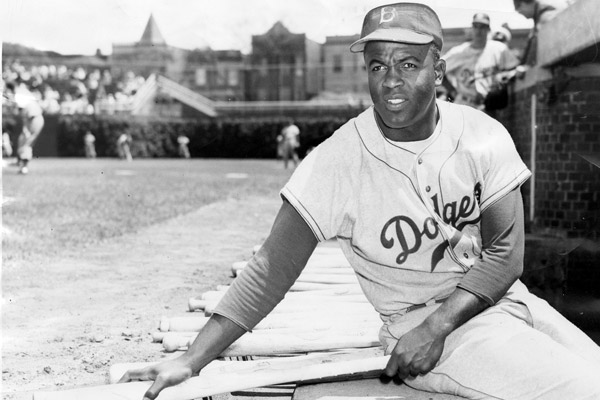
Ray Gora/Chicago Tribune
In May 1947, Jackie Robinson made his debut in Chicago, in front of a sold-out crowd at Wrigley Field, and in front of a young Mike Royko, who grabbed a foul ball Robinson hit. When Robinson died, Royko wrote a column about the day, and about selling the ball to a black man for $10 (about a day's pay) that reminds me of Don DeLilllo's Pafko at the Wall:
When I left the ball park, with that much money in my pocket, I was sure that Jackie Robinson wasn't bad for the game.
Since then, I've regretted a few times that I didn't keep the ball. Or that I hadn't given it to him free. I didn't know, then, how hard he probably had to work for that ten dollars.
Someone else captured film of that day at Wrigley.
But it was not, apparently, the first time Robinson had played baseball for a Chicago audience. In 1997, the Tribune's William Hageman reported that Robinson did a tryout with the White Sox in 1942, five years before he became a Dodger. The only paper that reported it at the time was the Daily Worker, though it does come up in a 1970 Ebony article about black sportswriters, as related by Herman Hill, who was the West Coast editor of the Pittsburgh Courier. Hill claims credit for setting it up:
"I took Jackie Robinson, just out of Pasadena Junior College and Nate Moreland, a good, young pitcher from the same school, over to the Chicago White Sox camp, then at Brookside Park in Pasadena, to ask for a tryout. Jimmy Dykes, manager of the White Sox, had once praised Robinson and said he was worth $60,000 of anybody's money. Dykes had seen Jackie play semi-pro ball. But he blushed when we came on the diamond. He refused to pose for pictures with Jackie and Nate."
Nothing became of it, and Robinson was drafted into the Army later that year. What's interesting about Hageman's piece is that he takes this bit of obscure baseball history and speculates what might have been. Hageman asked Leon Forrest, the late Northwestern prof and novelist (Divine Days) what it would have been like had Robinson broken the color line at Comiskey:
"It would have been really tumultuous," adds Leon Forrest, novelist and professor of African-American Studies and English at Northwestern University. "Jackie said the cities that he caught the most hell in were Chicago, St. Louis and Cincinnati. (His playing for the Sox) would have meant a confrontation of (black and white) South Siders. As a youngster growing up on the South Side, I ran into some rough white gangs. And Jackie certainly would have caught hell from white West Siders."
When Robinson finally did reach the majors, National League president Ford Frick broke the news that when the St. Louis Cardinals were scheduled to play an early-season series against the Dodgers, "there was a movement among the Cardinals to strike in protest," but the team's owner had talked them out of it.
The late historian Jules Tygel, author of Baseball's Great Experiment: Jackie Robinson and his Legacy, told Hageman that in the end, Robinson landed on the right team in the right place:
"Brooklyn was a very liberal community," Tygiel explains. "It was almost the perfect place for Jackie. There was a large black population, a large Jewish population, a large immigrant population. These people were very sympathetic to Jackie and his plight.
"(Robinson's arrival) gave Brooklyn another claim to its own identity. In Brooklyn, there was always the feeling that it was overshadowed by New York. So people wanted a way to stand out. Something to be proud of. And one way was through their Dodgers, something no one else had. And now they had Jackie Robinson. It reflected very well on the borough."
It took another four years for the Sox to integrate, with Minnie Minoso. The Cubs integrated in 1953 with Ernie Banks and Gene Baker,* the first black double-play team.
*Baker was a pretty good player—he made the All-Star team in 1955, leading the majors in sac bunts—but his legacy was as the majors' first black manager, on the Pirates' New York-Penn league farm team, and as the second black coach on a major-league team.
Related: Jonathan Eig, author of Opening Day: The Story of Jackie Robinson's First Season on Robinson's Wrigley debut (Bud Selig and Herb Kohl were also there); Kimbriell Kelly (former Chicago Reporter editor, current Washington Post reporter, and distant cousin of UIC great Curtis Granderson) on baseball's declining black representation.
Also: Steve Bogira on the integration of Loyola's championship basketball team and [my former boss] Mike Lenehan's new book on it, Ramblers:
Much of its power comes from the stories told by the players—stories that remind us that progress on integration is easier on courts and fields than off. [Team captain Jerry] Harkness was drafted by the Knicks, but soon was cut. He got a job as a salesman for Quaker Oats and was transferred back to Chicago. Less than two years after he led Loyola to the title, he and his wife tried to rent an apartment in Edgewater, not far from the Loyola campus. The landlord "didn't want blacks in the building," Lenehan writes. Harkness and his wife ended up on the black south side.


